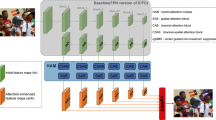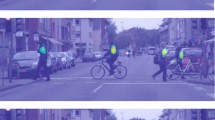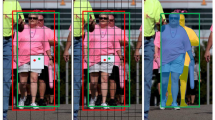Abstract
To elude from the camera, suspects often hide behind other things or persons, leading to a series of occlusion patterns. These suspects are notoriously hard to search due to the substantially various appearance in the intricate occlusion patterns. Existing methods solving occlusion problem depend on learning several frequent patterns separately. It brings not only high consumption but also less coverage of patterns in real application scenarios. Different from the current researches which only concern certain patterns that do not synthesize the occlusion patterns in practical applications, we consider a wide range of occlusion patterns which conform the real application scenarios in one coherent model with less interference of both the occlusion and background areas and without redundant computation. Consequently, we propose a channel-guided mechanism (CGM) for occluded suspect search in this paper. The core idea is that different body areas have been activated via different channels in convolutional neural networks. By suppressing the effects of the interference areas, such as occlusion and background areas, we can filter out the visible areas which are the essential elements for the occlusion patterns. Channel-aware attention is introduced to learn the relation between areas and channels. Furthermore, we can identify suspects using a rule which focuses more on the visible area and focuses less on the occluded area in the specific occlusion pattern. Extensive evaluations on two challenging datasets confirm the effectiveness of the proposed CGM.





Similar content being viewed by others
References
Song W, Zheng J, Wu Y, Chen C, Liu F (2019) A two-stage attribute-constraint network for video-based person re-identification. IEEE Access 7:8508–8518
Lin L, Luo H, Huang R, Ye M (2019) Recurrent models of visual co-attention for person re-identification. IEEE Access 7:8865–8875
Li T, Sun L, Han C, Guo J (2018) Salient region-based least-squares log-density gradient clustering for image-to-video person re-identification. IEEE Access 6:8638–8648
Nanda A, Sa PK, Choudhury SK, Bakshi S, Majhi B (2017) A neuromorphic person re-identification framework for video surveillance. IEEE Access 5:6471–6482
Xiao T, Li S, Wang B, Lin L, Wang X (2017) Joint detection and identification feature learning for person search. In: IEEE Conference on computer vision and pattern recognition, pp 3376–3385
Zheng L, Zhang H, Sun S, Chandraker M, Yang Y, Tian Q (2017) Person re-identification in the wild. In: IEEE Conference on computer vision and pattern recognition, pp 3346–3355
Enzweiler M, Eigenstetter A, Schiele B, Gavrila DM (2010) Multi-cue pedestrian classification with partial occlusion handling. In: IEEE Conference on computer vision and pattern recognition, pp 990–997
Wu B, Nevatia R (2005) Detection of multiple, partially occluded humans in a single image by Bayesian combination of edgelet part detectors. In: IEEE International conference on computer vision, pp 90–97
Mathias M, Benenson R, Timofte R, Van Gool V (2014) Handling occlusions with franken-classifiers. In: IEEE International conference on computer vision, pp 1505–1512
Tian Y, Luo P, Wang X, Tang X (2015) Deep learning strong parts for pedestrian detection. In: IEEE International conference on computer vision, pp 1904–1912
Ren S, He K, Girshick R, Sun J (2015) Faster r-CNN: towards real-time object detection with region proposal networks. In: Conference and workshop on neural information processing systems (NeurIPS), pp 91–99
Zheng L, Shen L, Tian L, Wang S, Wang J, Tian Q (2016) Scalable person re-identification: a benchmark. In: IEEE International conference on computer vision, pp 1116–1124
Liao S, Hu Y, Zhu X, Li SZ (2015) Person re-identification by local maximal occurrence representation and metric learning. In: IEEE Conference on computer vision and pattern recognition, pp 2197–2206
Zhao R, Ouyang W, Wang X (2013) Unsupervised salience learning for person re-identification. In: IEEE Conference on computer vision and pattern recognition, pp 3586–3593
Koestinger M, Hirzer M, Wohlhart P, Roth PM, Bischof H (2012) Large scale metric learning from equivalence constraints. In: IEEE Conference on computer vision and pattern recognition, pp 2288–2295
Dalal N, Triggs B (2005) Histograms of oriented gradients for human detection. In: IEEE Conference on computer vision and pattern recognition, pp 886–893
Dollár P, Appel R, Belongie SJ, Perona P (2014) Fast feature pyramids for object detection. IEEE Trans Pattern Anal Mach Intell 36(8):1532–1545
Nam W, Dollar P, Han JH (2014) Local decorrelation for improved pedestrian detection. In: Advances in neural information processing systems, volume 27: annual conference on neural information processing systems 2014, December 8–13 2014, Montreal, Quebec, Canada, pp 424–432
Zhang S, Benenson R, Schiele B (2015) Filtered channel features for pedestrian detection. In: IEEE Conference on computer vision and pattern recognition, pp 1751–1760
Girshick R, Donahue J, Darrell T, Malik J (2014) Rich feature hierarchies for accurate object detection and semantic segmentation. In: IEEE Conference on computer vision and pattern recognition, pp 580–587
Girshick R (2015) Fast r-CNN. In: IEEE International conference on computer vision 2015, pp 1440–1448
Redmon J, Farhadi A (2018) Yolov3: an incremental improvement. arXiv preprint arXiv:1804.02767
Liu W, Anguelov D, Erhan D, Szegedy C, Reed S, Fu CY, Berg AC (2016) Ssd: single shot multibox detector. In: European conference on computer vision, pp 21–37
Xiao T, Li S, Wang B, Lin L, Wang X (2016) End-to-end deep learning for person search. arXiv preprint arXiv:1604.01850
Mathias M, Benenson R, Timofte R, Van Gool L (2013) Handling occlusions with franken-classifiers. In: IEEE International conference on computer vision, pp 1505–1512
Farenzena M, Bazzani L, Perina A, Murino V, Cristani M (2010) Person re-identification by symmetry-driven accumulation of local features. In: IEEE Conference on computer vision and pattern recognition, pp 2360–2367
Dollar P, Tu Z, Perona P, Belongie S (2009) Integral channel features. In: British machine vision conference, pp 1–11
Ouyang W, Wang X (2012) A discriminative deep model for pedestrian detection with occlusion handling. In: IEEE Conference on computer vision and pattern recognition, pp 3258–3265
Tian Y, Luo P, Wang X, Tang X (2016) Deep learning strong parts for pedestrian detection. In: IEEE International conference on computer vision, pp 1904–1912
Zhao L, Li X, Zhuang Y, Wang J (2017) Deeply-learned part-aligned representations for person re-identification. In: IEEE International conference on computer vision, pp 3239–3248
Ouyang W, Zeng X, Wang X (2015) Single-pedestrian detection aided by two-pedestrian detection. IEEE Trans Pattern Anal Mach Intell 37(9):1875–1889
Tang S, Andriluka M, Schiele B (2014) Detection and tracking of occluded people. Int J Comput Vis 110(1):58–69
Ouyang W, Wang X (2014) Joint deep learning for pedestrian detection. In: IEEE International conference on computer vision, pp 2056–2063
Zhou C, Yuan J (2017) Multi-label learning of part detectors for heavily occluded pedestrian detection. In: IEEE International conference on computer vision, pp 3506–3515
Bell S, Lawrence Zitnick C, Bala K, Girshick R (2016) Inside-outside net: detecting objects in context with skip pooling and recurrent neural networks. In: IEEE Conference on computer vision and pattern recognition, pp 2874–2883
Jaderberg M, Simonyan K, Zisserman A, Kavukcuoglu K (2015) Spatial transformer networks. In: Conference and workshop on neural information processing systems (NeurIPS), pp 2017–2025
Newell A, Yang K, Deng J (2016) Stacked hourglass networks for human pose estimation. In: IEEE International conference on computer vision, pp 483–499
Hu J, Shen L, Sun G (2018) Squeeze-and-excitation networks. In: 2018 IEEE Conference on computer vision and pattern recognition, CVPR 2018, Salt Lake City, UT, USA, June 18–22, 2018, pp 7132–7141
Bau D, Zhou B, Khosla A, Oliva A, Torralba A (2017) Network dissection: quantifying interpretability of deep visual representations. In: 2017 IEEE Conference on computer vision and pattern recognition, CVPR 2017, Honolulu, HI, USA, July 21–26, 2017, pp 3319–3327
He K, Zhang X, Ren S, Sun J (2016) Deep residual learning for image recognition. In IEEE Conference on computer vision and pattern recognition, pp 770–778
Zhang S, Benenson R, Schiele B (2017) Citypersons: a diverse dataset for pedestrian detection. In: 2017 IEEE Conference on computer vision and pattern recognition, CVPR 2017, Honolulu, HI, USA, July 21–26, 2017, pp 4457–4465
Felzenszwalb PF, Girshick RB, McAllester DA, Ramanan D (2010) Object detection with discriminatively trained part-based models. IEEE Trans Pattern Anal Mach Intell 32(9):1627–1645
Yang B, Yan J, Lei Z, Li SZ (2015) Convolutional channel features. In IEEE International conference on computer vision, pp 82–90
Xiao J, Xie Y, Tillo T, Huang K, Feng J (2019) IAN: the individual aggregation network for person search. Pattern Recognit 87:332–340
Xiao J, Xie Y, Tillo T, Huang K, Feng J (2017) Neural person search machines. In: IEEE International conference on computer vision, pp 493–501
Wu L, Shen C, Van Den Hengel A (2016) Personnet: person re-identification with deep convolutional neural networks. arXiv preprint arXiv:1601.07255
Acknowledgements
This work was supported by National Nature Science Foundation of China (U1803262, U1736206, 61876135) and National Key R&D Program of China (No. 2017YFC0803700).
Author information
Authors and Affiliations
Corresponding author
Ethics declarations
Conflict of interest
The authors declare that they have no conflict of interest.
Additional information
Publisher's Note
Springer Nature remains neutral with regard to jurisdictional claims in published maps and institutional affiliations.
Rights and permissions
About this article
Cite this article
Huang, W., Hu, R., Wang, X. et al. Occluded suspect search via channel-guided mechanism. Neural Comput & Applic 33, 961–971 (2021). https://doi.org/10.1007/s00521-020-05314-7
Received:
Accepted:
Published:
Issue Date:
DOI: https://doi.org/10.1007/s00521-020-05314-7




